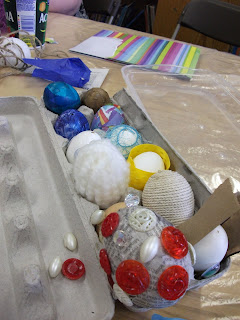Yesterday we had two graphic design classes come into the gallery from Carleton North High School. First, I'd like to mention how proud it makes me to live in an area that offers such a great art program. The very fact that there is not only one, but two full graphic design classes (along with numerous other art classes), speaks to the fullness of the offerings in visual education here. Kudos to the highschool and their art staff! I went to this highschool at one time and even then had the pleasure of learning and being encouraged in art by the very same art teacher, Mrs. Galbraith - although I'm attempting to transition to calling her just 'Susan' now! There were many university conversations where my peers were astounded to hear that I had been able to take graphic design in highschool, a program unheard of in their schools. The art curriculum here has continued to thrive and grow and I am so pleased to be able to take part now in offering access to visual education in our community.
The students were great participants as we discussed Joss' artwork and the topics of messaging, self-portraits, and in relation to their current studies, comparing and contrasting fine art and graphic design.
In both art and graphic design there is a message. There is what the artist/creator/designer intends to say through their work, and then what the viewer interprets.
And these two are not the same.
The intended message and the interpretation are different because everyone has a different bias, a different perspective and a different way of viewing the same visual clues. People's different perspectives are shaped by their experiences, influences in their lives, education, knowledge, and the information that is available to them. It's not only major events in one's life that shapes their perspective, but things the viewer has done and seen, the family the were raised in, their culture and heritage and language and community, world events that happen around a person, what era they were raised in and by whom. Education and knowledge not only refers to one's formal education, but the perspectives of their teachers and their informal education. The areas of interest one has pursued lead to areas of expertise and experience in certain fields. We discussed how everyone has topics that pique their interest, leading them to notice and read up on the topic, to watch shows on the topic, to immerse themselves in activities of that topic. All of these elements create a person's unique perspective that effects their interpretation of anything, in this case art.
We discussed what messages the art conveyed to them purely through the work itself, and then added the element of how extra information on the exhibition impacts their interpretation. We discussed how the title of the show, 'Further Evidence of Human Presence' and the titles of the artwork, along with the artists statement and the conversations a few students and myself had had with Joss himself on his art, impacted our interpretations of the art. The more information we have on the show opens us up to noticing and reading more visual clues.
The main difference between art and graphic design lies in this messaging. Fine art has the opportunity to be much more subjective, the message can be less clear and up for interpretation. The viewer is invited to consider and ponder the work and the artist's message, deciphering what it means to them personally. Graphic design however has to grapple with this point of perspective and attempt to attain objectivity. The graphic designer, paid by a client to communicate a certain message, tries to lessen the gap and variables between the intended message and the interpretation, presenting the most clear message possible by finding shared experiences.














